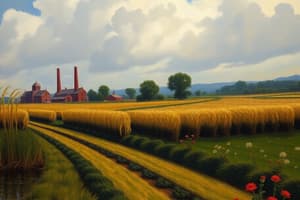Podcast
Questions and Answers
Why do some people argue that the changes in agriculture from 1750 to 1850 were not completely new?
Why do some people argue that the changes in agriculture from 1750 to 1850 were not completely new?
Some believe that the changes were a continuation of a process that had started much earlier.
What was one of the reasons for considering the events between 1750 and 1850 as a revolution in agriculture?
What was one of the reasons for considering the events between 1750 and 1850 as a revolution in agriculture?
Growing population levels sustained by self-sufficiency in food.
How did the population in England change between 1750 and 1850?
How did the population in England change between 1750 and 1850?
The population grew from approximately 6 million to nearly 17 million.
What was one factor that led to the start and sustenance of the Agrarian Revolution in England?
What was one factor that led to the start and sustenance of the Agrarian Revolution in England?
What happened to food production as the population grew between 1750 and 1850?
What happened to food production as the population grew between 1750 and 1850?
What impact did the Enclosure Laws have on ordinary people in England?
What impact did the Enclosure Laws have on ordinary people in England?
Why did productivity rise after 1750 despite fewer people working in agriculture?
Why did productivity rise after 1750 despite fewer people working in agriculture?
What were the Enclosures and how were they viewed by many?
What were the Enclosures and how were they viewed by many?
What percentage of the workforce was employed in agriculture in 1850 when the population was at record levels?
What percentage of the workforce was employed in agriculture in 1850 when the population was at record levels?
What effect did the Enclosures have on the growth of farms in England?
What effect did the Enclosures have on the growth of farms in England?
What were some of the revolutionary ideas that contributed to the Agrarian Revolution in England?
What were some of the revolutionary ideas that contributed to the Agrarian Revolution in England?
Where did some of the revolutionary ideas for the Agrarian Revolution originate from?
Where did some of the revolutionary ideas for the Agrarian Revolution originate from?
Study Notes
Agricultural Revolution or Evolution?
- The 1750s marked a significant change in agriculture in England, driven by the need to feed a growing population.
Factors Contributing to the Agricultural Revolution
- Growing population levels sustained by self-sufficiency in food, with the population reaching approximately 6 million in 1750.
- The population continued to grow, reaching nearly 17 million by 1850, with food production increasing at a sufficient rate to maintain this level of population.
Productivity and Workforce
- Productivity rose after 1750, despite the proportion of the population employed in agriculture consistently dropping.
- By 1850, agriculture employed only 22% of the workforce, the lowest percentage in English history and lower than any of England's European competitors.
Social Changes and the Agrarian Revolution
- The Enclosure Laws led to the loss of common land for grazing, benefitting landowners and encouraging the growth of larger, more efficient farms.
- The Enclosures were bitterly resented by many and are still contentious today.
Ordinary People's Lives
- Life for ordinary people was very hard during this period, with many forced to leave rural areas due to the Enclosures.
- Cities offered an attractive alternative with new types of jobs and better wages for poor farm laborers and their families.
Revolutionary Ideas
- Some revolutionary ideas originated in England, while others were imported from Holland and Denmark and developed in East Anglia.
- These ideas fall into four categories:
- Scientific innovations, such as crop rotation and improvements to soil quality.
- Technological developments and new machines that spread quickly.
Studying That Suits You
Use AI to generate personalized quizzes and flashcards to suit your learning preferences.
Description
Explore the changes in agriculture in England from 1750 to 1850 and debate whether they constituted a revolution or an evolution. Discuss the factors influencing agricultural practices and the differing opinions on this historical period.




